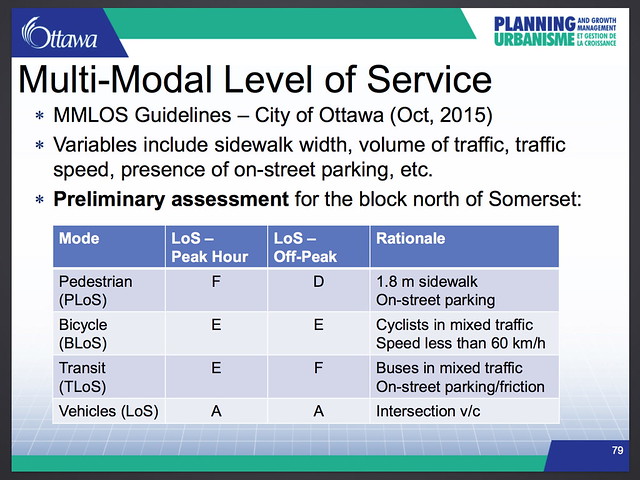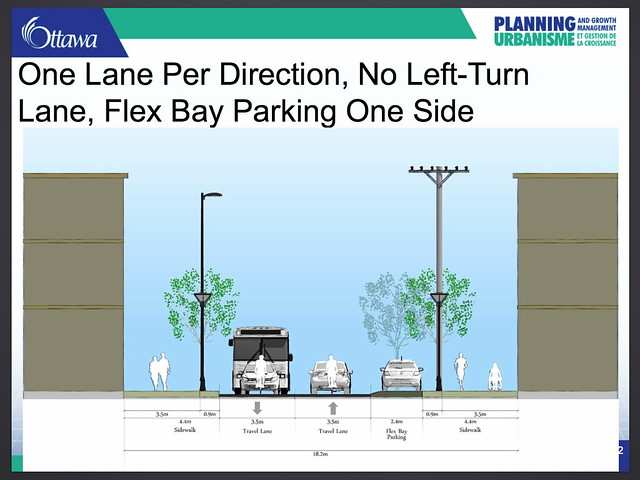Thanks to Catherine McKenney for posting the Elgin Street consultation deck (no longer available from her site) in advance of the public meeting that took place on June 28, 2016. Deck is available from the City of Ottawa.
UPDATE 2017-04-30: The final proposed redesign goes to Transportation Committee on May 3, 2017. I have provided my comments on the proposed redesign. ENDUPDATE
Particular kudos for including multi-modal Level of Service (LOS) which shows that cars get top level of service (A) while every other mode has a terrible experience.
From the many many options presented, here are my top three designs in order of preference, with my priority being on slowing cars, shortening crossing distances and other safety considerations:
1. One Lane Per Direction, No Left-Turn Lane, No On-Street Parking (slide 81 in the deck)
Pros:
- Having two narrow lanes in opposite directions provides the design signals that will cause cars to slow down dramatically.
- Expected slower speeds means cyclists can mix with traffic.
- Using space for pedestrians rather than parking means smoother traffic flow (no waiting for cars to enter, exit, or find parking spaces).
- Using space for pedestrians rather than parking means cyclists can’t be doored by parked cars or otherwise cut off by cars entering or exiting parking spaces.
- Maximizes sidewalk space, with equally-sized sidewalks on both sides. Good for a highly-pedestrian, mostly-restaurant-with-patio street.
- Wide sidewalks mean ample room for street trees (which will struggle nevertheless) and street furniture (being mindful that unless full width is plowed it still may be narrow in winter).
- Dramatically shorter crossing distance will mean safer, quicker crossings.
Cons:
- Doesn’t have parking but there is lots of parking nearby, including side streets, 850 (!) spaces at City Hall for $5/hour weekdays ($2 max on weekends), and NAC.
- Doesn’t have separated bike lanes (cycle tracks) but I think these would interfere with the bus stops.
2. One Lane Per Direction, No Left-Turn Lane, Flex Bay Parking One Side (slide 82 in deck)
Pros:
- Having two narrow lanes in opposite directions provides the design signals that will cause cars to slow down dramatically.
- Expected slower speeds means cyclists can mix with traffic.
- Will make people who complain about needing on-street parking somewhat happy
Cons:
- There is no such thing as “flex bay” parking (i.e. parking that is at sidewalk level so in theory available for pedestrian space). The Lansdowne experience shows that anything in Ottawa that looks like car space will be used as car space.
- Cyclists can be doored by parked cars or otherwise cut off by cars entering or exiting parking spaces.
- Disrupted traffic flow (waiting for cars to enter, exit, or find parking spaces).
- Doesn’t have separated bike lanes (cycle tracks) but I think these would interfere with the bus stops.
- Much less sidewalk space (1.2 metres less per side) for pedestrians, trees and street furniture than first option
3. One Lane Per Direction, No Left-Turn Lane, Raised Cycle Track, No Parking (slide 89 in deck)
Pros:
- Having two narrow lanes in opposite directions provides the design signals that will cause cars to slow down dramatically.
- Using space for pedestrians and cyclists rather than parking means smoother traffic flow (no waiting for cars to enter, exit, or find parking spaces).
- Using space for pedestrians and cycling rather than parking means cyclists can’t be doored by parked cars or otherwise cut off by cars entering or exiting parking spaces (except see cycle-track-as-parking issue below)
Cons:
- Narrowest sidewalk option (0.6 metres less per side than option two; 1.8 metres less than option one)
- Cycle track may interfere with bus stops
- Even with an elevated cycle track, vehicles will still manage to park on the cycle track, which will both disrupt traffic flow and interfere with cycling
It may surprise people that I don’t automatically recommend cycle tracks. I do strongly support them. But I’m not convinced we can make them work well on a street with buses where people will also be tempted to use them for car parking. I think cycle tracks with barriers or cycle tracks protected by buffered car parking work better. It doesn’t appear that there is space to do either. Nevertheless, any of these three options would be much better than the status quo.
It’s hard to get the visitor traffic that centres around the Convention Centre and Parliament Hill to circulate down Elgin Street; having a dramatically better pedestrian experience will be key to drawing this traffic so that visitors can experience more of Ottawa than just the Byward Market.
I would also like the street to be signed for 30km/h, being mindful that only design controls speed.
The city contact on this file is Vanessa Black. If you have thoughts on the Elgin Street redesign, make sure that you share them with her.
Vanessa Black, P. Eng.
Transportation Engineer – Network Modification
Planning and Growth Management
City of Ottawa
110 Laurier Avenue West
Ottawa, ON K1P 1J1
Email: vanessa.black@ottawa.ca
Email: planning@ottawa.ca
The city site for this particular consultation was http://ottawa.ca/en/city-hall/public-consultations/elgin-street-and-hawthorne-avenue-functional-design-study
There was also a quick survey about Elgin Street that you could fill out, in order to indicate your priorities for the redesign.



